.
Parts: 1 - 2 - 3 - 4 - 5 - 6 -
Olympic Program, Women Sport, Olympic Fire, Links
As one passes out of the stadium (Olympia) ... one comes to the hippodrome and the starting gate for the horses.. This starting gate looks like the forepart of a ship, with the projecting bows pointing towards the track. The prow is the widest where it is nearest the Stoa of Agnaptos; at the very tip of the projection is a bronze dolphin on a pole. Each wing of the gate, with the stalls built into it, is more than 400 feet long. The entrants for the equestrian events consists of a cord passing through the stalls. For each Olympiad a plinth of unbaked brick is built at about the middle of the prow, and on this plinth is a bronze eagle with its wings fully extended. The starter works the mechanism on the plinth when it is set in motion, it causes the eagle to jump up so it becomes visible to the spectator, while the dolphin falls to the ground. Pausanias

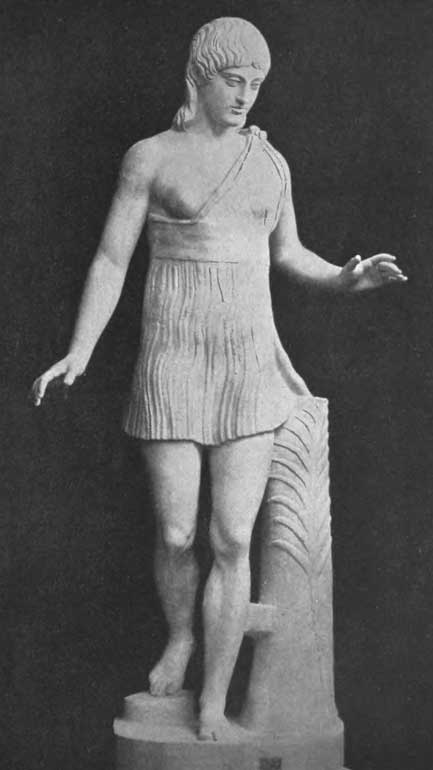
A Heraria spartan woman and a sculpture for a victress around 460 BC Vatican Museum, description of this type of sculptures by Pausanias in 5.16.3
Bronze figure of a running girl
There were versions of games for adult athletes and for boys but also a special competition was held for unmarried women in Olympia (Heraria in honor of Hera). Organized by women (Three sprint races of reduced length). Unlike men who compete naked women wore a short dress. The competition was introduced according to legend by the wife of Pelops, Hippodameia.
At the Heraean Games the girls competed divided into three teams according to their age. During events their hair was allowed to fall loose on their shoulders and they wore a short chiton tunic which reached down to their knees but left bare their left shoulder and breast. As in the case of male Olympic winners, the prize for them too was a wreath of wild olive as well as the right to dedicate a tablet depicting themselves at the temple of Hera (Paus. 5,6,3. Gardiner, Olympia 214 ff). One of the first winners at the games for women, the Heraean Games, was, according to the legend, Chloris, the only one among the daughters of Niobe who survived after the relentless slaughter of her remaining children by Apollo and Artemis as a punishment to their mother for her arrogance. But Artemis spared Chloris for the very reason that she had participated at the Heraean Games and won a victory (Comm. to the Iliad, Omega 615 a., Diod. 4,7a4, 3-4). However, another explanation of how the Heraean Games came into being which remained popular throughout ancient times is given to us in great detail by Pausanias (V 14,5); he writes: After the death of the tyrant Damophon, as, on the one hand the Pisaeans wanted to assure the rest of the world that they had never approved of his wrongdoings and on the other hand the Eleans wished to put an end to the acts of violence against them, they both selected one woman, the oldest and most respected for her authority and good name, among the female population of each of the sixeen cities which were still inhabited at the time in Elis and Pisa, and then assigned to these sixteen women the task of settling the differences between the two kingdoms. These women did indeed succeed in bringing about a reconcilation between the Eleans and the Pisaeans, and later on they were assigned the task of organizing games in honour of the goddess Hera. This is a significant fact, i.e. that the task of pacification is not assigned to men but to women, i.e. to these sixteen delegates from an equal number of cities in Elis and Pisa. Nikos Yalouris WOMEN IN ANCIENT GREECE THEIR CONTRIBUTION TO LETTERS, SCIENCE, POLITICS AND SPORT
Games for Girls , Image Footrace of young girls in the Arkteia Festival
In the Minoan civilization men and women participated in the dangerous bull leaping game.
After 396 BC in Olympia (at the 96th game) also a contest of messengers and trumpeters in order to obtain the privilege to announce the athletes during the Games.
While except the Heraria only men competed in the Games there are also reports of “mixed” activities (Hellenistic time):
On the island Chios the most pleasant thing is to walk over to the gymnasiums and running-tracks and to watch the young men wrestling with the girls. Athenaeus. The Deipnosophists. XIII.
Such mixed wrestling exercises were also performed in Sparta according to an advice by Lykourgos (Lycurgus).
Stamati Revithi, a Greek women in 1896 who completed the Marathon run but was not allowed to enter into the stadium as no women were allowed to participate in the first modern Olympic Games. Not knowing her name she was called Melpomene, the name of the Muse of tragedy.
Why is Plato against women in Olympia?
The Program of Olympia
The Games were held during the summer and were arranged so that a full moon lit the celebrations on the third night.
1st Day: Morning: Swearing-in ceremony. Contests for heralds and trumpeters. Boys' running, wresting and boxing contests. Prayers and sacrifices in the Altis; consultation of oracles. Afternoon: Speeches by philosophers, poets and historians. Tours of the Altis.
2nd Day: Morning: Procession in the hippodrome of competitors in the equestrian events. Chariot and horse races. Afternoon: Pentathlon. Evening: Funeral rites in honor of Pelops. Parade of victors around the Altis. Singing of victory hymns.
3rd Day: Morning: Procession of the judges, ambassadors, competitors, and sacrificial animals to the Great Altar. Afternoon: Running races. Evening: Public banquet in the Prytaneion. In the middle of the 4 days program honoring Zeus.
4th Day: Morning: Wrestling event. Midday: Boxing and pancration. Afternoon: Hoplitodromos.
5th Day: Procession of victors to the Temple of Zeus, to be crowned by the judges with garlands of wild olives. A day of feasting and rejoicing.
Until 632 BC the Games duration was 1 to 3 days and from the 5th century the games lasted for 5 days. xThis program changed during the millennium and it was extended to even 7 days. Some give a different program. The programs are reconstructed from fragments written by Philostratos (Gymn. 7), Pausanias (3,14), Plutarch (Symp. 2,5) and Lucian (Peregr.).
Those athletae who conquered in any of the great national festivals of the Greeks were called hieronicae (ieronikai), and received, as has been already remarked, the greatest honours and rewards. Such a conqueror was considered to confer honour upon the state to which he belonged; he entered his native city in triumph, through a breach made in the walls for his reception, to intimate, says Plutarch, that the state which possessed such a citizen had no occasion for walls. He usually passed through the walls in a chariot drawn by four white horses, and went along the principal street of the city to the temple of the guardian deity of the state, where hymns of victory were sung. Those games, which gave the conquerors the right of such an entrance into the city, were called iselastici (from eiselaunein). This term was originally confined to the four great Grecian festivals, the Olympian, Isthmian, Nemean, and Pythian; but was afterwards applied to other public games, as, for instance, to those instituted in Asia Minor (Suet. Ner.25; Dion Cass. lxiii.20; Plut. Symp. ii.5§2; Plin.Ep.x.119, 120). In the Greek states the victors in these games not only obtained the greatest glory and respect, but also substantial rewards. They were generally relieved from the payment of taxes, and also enjoyed the first seat (proedria) in all public games and spectacles. Their statues were frequently erected at the cost of the state, in the most frequented part of the city, as the market-place, the gymnasia, and the neighbourhood of the temples (Paus. vi.13§1, vii.17§3). At Athens, according to a law of Solon, the conquerors in the Olympic games were rewarded with a prize of 500 drachmae, and the conquerors in the Isthmian, with one of100 drachmae (Diog. Laërt. i.55; Plut. Sol. 23); and at Sparta they had the privilege of fighting near the person of the king (Plut. Lyc. 22). The privileges of the athletae were preserved and increased by Augustus (Suet. Aug.45); and the following emperors appear to have always treated them with considerable favour. Those who conquered in the games called iselastici received, in the time of Trajan, a sum from the state, termed opsonia (Plin.Ep.x.119, 120; compare Vitruv. ix. Praef.). By a rescript of Diocletian and Maximian, these athletae who had obtained in the sacred games (sacri certaminis, by which is probably meant the iselastici ludi) not less than three crowns, and had not bribed their antagonists to give them the victory, enjoyed immunity from all taxes (Cod.10tit.53). William Smith, A Dictionary of Greek and Roman Antiquities, John Murray, London, 1875.
Vitruvius does not like that athletes are treated as heroes, whereas Scientists who are more important are ignored. A situation that did not change until today.
Athletes in the running games had to start simultaneously otherwise they were disqualified and to some reports even beaten.
How did the Greeks start their races? Originally, they probably used an auditory signal, either an official saying "Go" or perhaps a trumpet blast. Runners could anticipate the signal and start too soon, hence the invention of a starting gate, or hysplex. Inspired by the representation of a gate on a fourth-century Athenian vase, Stephen G. Miller of the University of California, Berkeley, and his Greek colleague Panos Valavanis reconstructed a form of the hysplex on the balbis of the stadium at Nemea in 1993 (see their work, Hysplex: The Starting Mechanism in Ancient Stadia. A Contribution to Ancient Greek Technology [1999].) This hysplex functions like the simple mousetrap. Between poles at each end of the balbis, ropes are stretched to form a barrier. Utilizing torsion from twisted ropes, the gate is lowered onto the ground, then raised against the tension and kept in a vertical position by a ring and cord fastened to larger stationary posts at each end. The rings are also attached to ropes held by an official standing behind the runners. When he jerks the ropes, the rings slip off the poles, the gate slams forward, and the runners spring onto the track. Hugh M. Lee, University of Maryland, College Park.
Images of a Balbis (pl. Balbides) (site offline)
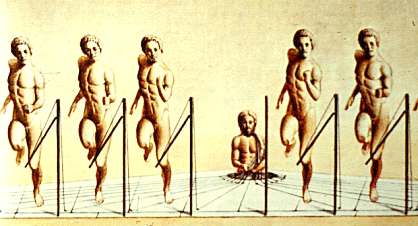 |
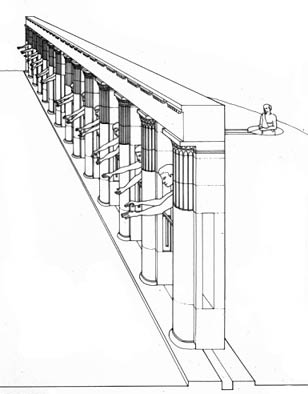
A more advanced Hysplex version from Kos (a reconstruction), 150 BC (Source which includes more images of the remains of these starting devices) |
|
Hysplex starting mechanism (different versions exist). The start signal maybe a sequence of calls such as “poda para poda”, and “aphete” i.e. foot by foot and go.
|
|
|
|
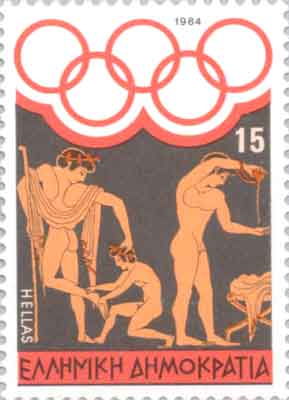  
From the Euphronios Krater, 510-500 BC, left Hippomedon and Tranion, Pergamon Museum Berlin. Inv. Nr. F 2180 |
Hellanodikes
|
The Krypte (constructed in the Hellenistic period) through which the Hellanodikai and the athletes entered into the stadium of Olympia. The passageway connected the stadium to the sanctuary (which included the Zeus Temple) |
|
|
Athletes had to be in Olympia one month before the Games where the Hellanodikes judged their abilities and if they could participate. Hellanodikes means judges of the Hellenes (Greeks). The Hellanodikai were elected by lot from among the highly esteemed citizens of Elis, 10 months before the Games, and the eldest was the chairman. For the whole of the ten months period they resided at the Hellanodikaeon where the guardians of the regulations (nomophylakes) taught them their duties (Paus. 6,24,3). They supervised the Games and declared the victors. |
|
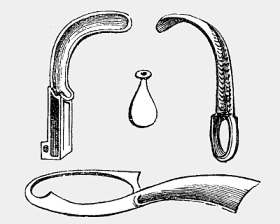
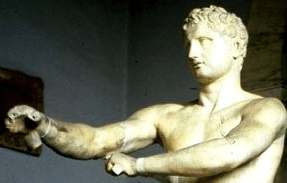
Athletes used to cover their body with oil (oil from an aryballos, wrestlers used also sand) that they scrapped off with a bronze scraper (strigil). In the Image above the instrument and the Apoxyomenos, a sculpture (a copy of Lysippos original work c. 330 BC) showing the athlete using it.
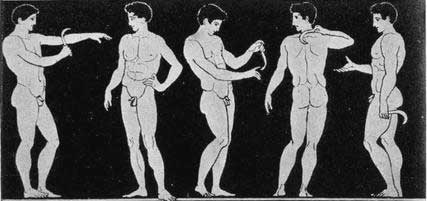
Athletes using the strigil, British Museum Kylix, N0.E83.
There were other persons like the Rabdouhoi, Mastigoforoi (beating the persons who did not follow the rules) and Alytarches playing the role of a police force. According to Cleanthis Palaeologos, Honorary Director of the National Academy, of Physical Culture of Greece here a list of people working for the Olympic Games:
The theicolos (the priest), mandes (the oracles) (who gave soothsayings to the worshippers), the spondophoroi (who bore the tidings of the truce), the exigites (who acted as host to the visitors), the aulites (the flute-player), the xyleus (the provider of wood) who provided the worshippers with special timber of poplar wood for the sacrifices), the epimelites (the quartermaster), the peigetes (he accompanied the visitors), the grammateus (the secretary), the spondaules (he regulated the matters dealing with libations and sacrifices), the epispondorchistae (the libation masters), the hypospondorchistae (the assistant libation masters), the kathemorothytes (the officer of the day), the oenoshoos (the keeper of the wine), the kleidouchos (the holder of the keys), the mageiros (the cook), the archimageiros (the chief cook), the artokopos (the bread-cutter), the architecton (the architect), the steganomos (the officer who had the responsibility of the buildings), the iatros (the doctor). All this personnel lodged at Olympia, especially during the ten months period. Some of the above resided permanently at Olympia.
| Ancient Greece
Science, Technology , Medicine , Warfare, , Biographies , Life , Cities/Places/Maps , Arts , Literature , Philosophy ,Olympics, Mythology , History , Images Medieval Greece / Byzantine Empire Science, Technology, Arts, , Warfare , Literature, Biographies, Icons, History Modern Greece Cities, Islands, Regions, Fauna/Flora ,Biographies , History , Warfare, Science/Technology, Literature, Music , Arts , Film/Actors , Sport , Fashion --- |

 Aryballos (Αρύβαλλος) (a small bottle) filled with olive oil used by athletes to cover their body. Laconian Aryballoi were widely exported.
Aryballos (Αρύβαλλος) (a small bottle) filled with olive oil used by athletes to cover their body. Laconian Aryballoi were widely exported.


